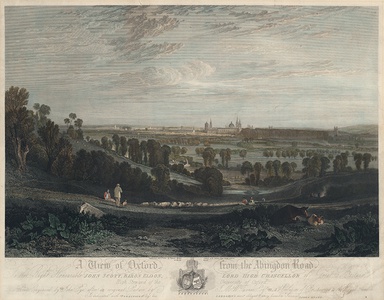| Method | Copper engraving with hand colouring |
| Artist | John Pye after J.M.W. Turner |
| Published | Published February 13th 1818. By James Wyatt Carver and Gilder, High Street, Oxford. as the Act directs. |
| Dimensions | Image 406 x 606 mm |
| Notes |
Dedication below title states: 'To the Right Honourable John Scott, Baron Eldon, Lord High Chancellor of Great Britain, High Steward of the University of Oxford. This Plate Engraved by John Pye after an original Picture by J.M.W.Turner Esq. R.A. Professor of Perspective to the Royal Academy. Is dedicated with Permission by his Lordship's most obliged & very humble Servant, James Wyatt.' A companion print to Turner's view of the High Street this fine view of the city beyond the village of South Hinksey gives a splendid portrait of tranquillity compared with the hustle and bustle of the countryside round Oxford today. A landscape steeped in history is united with scenes of rural productivity by the diffusion of light and shadow caused by the sky. Inspired by the landscape painters of the Dutch Golden Age, Turner's work seems to adhere to the seventeenth-century concept of houding. The idea of houding proffered the idea that spatial recession could be achieved through the layering of tone and object. Thus, depth and distance are attained in a painting through the juxtaposition of light and dark. This can be seen in Turner's work as the light falls in sweeping fragments. Cows are eclipsed in shade but the chain of sheep are illuminated. Trees are dim but pastures beyond shimmer. On the horizon, the cityscape itself is divided into differing shards of tone. John Pye (1782-1874) was a British printmaker, writer and publisher. Born in Birmingham, Pye relocated to London in 1801 where he took residence in Cirencester Place and worked for many book publishers. As an illustrator for popular art annuals, he executed plates for landscapes by J. M. W. Turner, Claude Lorrain, and Gaspard Poussin amongst others. Preceding his Oxfordian views, Pye collaborated with Turner on James Hakewill's Italy as well as the History of Richmondshire. Pye grew more literary in his later years and in addition to his strong advocacy for the inclusion of engravers in the Royal Academy, he published a work entitled the Patronage of British Art. Joseph Mallord William Turner (1775 - 1851) was a painter and draughtsman who became one of the most celebrated artists Britain would ever produce. He was born near Covent Garden, London, and entered the Royal Academy Schools in December of 1789. The Academy, conscious of his prodigious talent, encouraged and supported Turner. He was elected as an Associate of the RA in 1799, and became a full Academician in 1802. His early oil painting flitted between Netherlandish works in the manner of Cuyp, Ruisdael and Van de Velde, classical landscapes like those of Claude and Richard Wilson, and, upon returning from his Parisian visit in 1802, grand historical compositions like those of Poussin and Titian. The development of his idiosyncratic style, commonly held to have been around 1803, led to critical condemnation. His preoccupation with light and colour produced abstract, near vorticistic works, which predated Impressionism, but were hugely controversial in the conformist context of late Georgian and early Victorian England. Whilst some critics accused Turner of extravagance and exaggeration, John Ruskin virulently thwarted these claims in Modern Painters, and championed the artist's fidelity to nature. Ruskin became the main advocate of a new generation of Turner admirers, usually professional, middle class, or newly wealthy, who embraced his work for its modernity. An enormously prolific artist, Turner bequeathed over three hundred oils and close to twenty thousand drawings and prints to the nation. His style produced many imitators, but no rivals. Condition: 'JW' Blindstamp. Toning from previous mount. Repaired tear to top margin. Surface staining and rubbing. Some scratches to sheet. |
| Framing | mounted |
| Price | £1,400.00 |
| Stock ID | 53398 |

